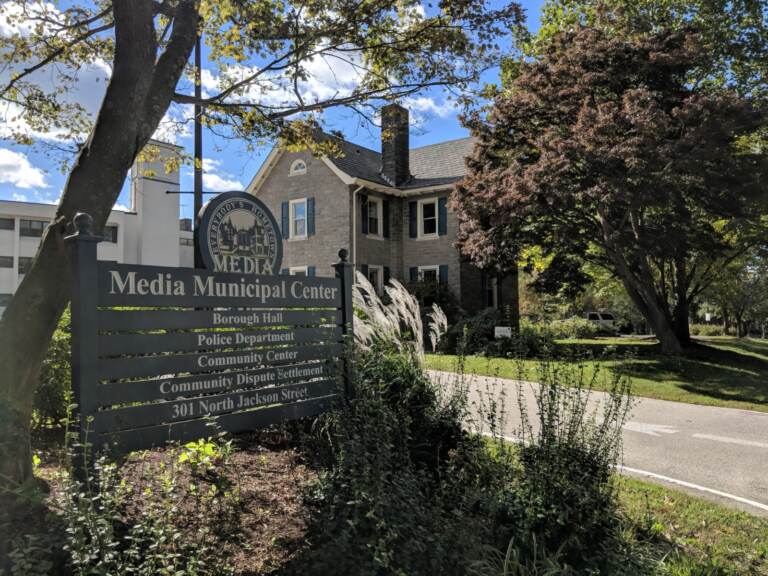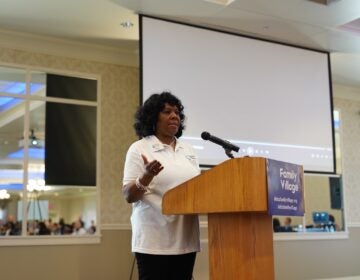‘Everybody’s Hometown’ is rewriting its zoning laws. Should other communities take note?
The Delaware County seat wants to incorporate form-based code into its zoning laws. This planning method organizes communities based on their physical form rather than use.

(@MediaBorough/Twitter)
Got a question about life in Philly’s suburbs? Our suburban reporters want to hear from you! Ask us a question or send an idea for a story you think we should cover.
Affectionately known by its roughly 6,000 residents as “Everybody’s Hometown,” Media Borough recently rolled out several municipal projects that caught the attention of neighboring communities.
But the Delaware County seat is not immune to many of the problems that plague the country, such as development clashes, housing affordability, and urban sprawl. That’s why Media’s newest project might be its most ambitious.
Media officials are considering changing some of the borough’s current zoning laws in favor of a little-known system called form-based code. The borough has yet to schedule a vote on this set of regulations, but its excursion into this relatively new system is sure to attract attention.
“There are three reasons why it is that we’re looking at amending our zoning code: One is development pressures, another is changes in living and working arrangements, and the third is potentially it could have some effect upon affordable housing,” said Borough Council President Brian Hall.

Not including park and open space areas, Media is roughly 95% built out. Hall said the borough is coming under development pressures that reflect its desirability. Therefore, the development is largely of infill in nature.
“The concern that we’ve heard from our residents is that the new development doesn’t always match or it doesn’t always fit in well with the diversity of housing that you see throughout the borough,” Hall said.
Media officials hope a change in zoning will spur new development that fits with the character of their historic town.
The change, if passed, would affect the zoning of residential areas only.
Media’s current zoning system — Euclidean zoning — is America’s status quo
The most commonly known type of zoning is single-use zoning. This means that the communities separate zones by land use such as residential, commercial, or industrial. Also known as Euclidean zoning, this urban planning method has been the predominant system in the U.S. since the Supreme Court ruled that local ordinance zoning was legal in 1926.
Phil Ehlinger is the planning director and deputy borough manager for the Borough of Doylestown. He is also the founder and former executive director of the Pennsylvania Association of Zoning Officials. He said that the intent of single-use zoning was to separate the uses of land from each other to reduce adverse impacts.
“The idea being you wouldn’t want a factory built in the middle of a bunch of houses, or you wouldn’t want a lot of houses built in a downtown commercial area. So this kind of compartmentalization of land uses — from residential to commercial to industrial — has been the norm in this country since the 1930s and 1940s,” Ehlinger said.
Outside of a small handful of exceptions, a vast majority of North American and even Australian and New Zealand communities use Euclidean zoning to shape neighborhoods. Despite its ubiquitousness in municipal planning, it has long been criticized for its role in segregation and urban sprawl.
Ehlinger believes that municipal planners have learned a lot over the years. He said that the lesson that he takes from history is that some of the best locations for living and working are places that mix up residential and some commercial uses.
“Some of the most vibrant communities are ones that would be completely illegal. Under Euclidean use-based zoning, Doylestown Borough, for instance … would be illegal under most traditional sounding paradigms, yet, it’s still a wonderful place to live and work and with a high quality of life,” Ehlinger said.
While land use is king in Euclidean zoning, aesthetics reign supreme in form-based code. In its purest shape, form-based code organizes neighborhoods based on the physical form and appearance rather than use.
What is form-based code?
Information on form-based code is rather difficult to come by. Because it is not the dominant form of zoning in America, it doesn’t have as big an academic footprint as Euclidean zoning.
WHYY News reached out to a few urban planning professors to speak on the topic, but they declined because they either were unaware of the system or did not know enough to be comfortable talking about it.
Form-based code does have its supporters. Toccarra Nicole Thomas is the executive director of the Form Based Code Institute, which is a program of the national nonprofit Smart Growth America.
The mission of the Form Based Code Institute is to advance zoning reform through the use of form-based codes. Thomas said the very beginnings of form-based code date back to the 1980s in Seaside, Florida. In the next decade, the plan’s originators worked together to refine form-based code as an alternative to form-based zoning.
The idea was simple: Focus on form.
“If you develop the form of buildings and you focus on that, instead of uses, it doesn’t really matter what is the use. The community figures out over time what they want the community to look like, because the building can be anything as long as it meets the form. It fosters predictable build results and a walkable public realm,” Thomas said.
She said that communities can apply the system to something as small as a parcel of land to an area as large as an entire county. The Form Based Code Institute has been highlighting communities excelling at implementing the planning method for 16 years.
“Some of the good examples are Denver Common Code and Miami 21,” Thomas said.
Ehlinger once served as a consultant on a form-based code project for the downtown district in Millersville, Pennsylvania. He said that the system prioritizes quality of life over “micromanaging” what happens inside of a building, which allows communities to be more market responsive.
“With form-based codes, if the development looks like what the community desires, if the buildings are of the right scale, if the architectural presentation and exterior materials are what the community desires, if the parking layout in the street cross sections and the pedestrian infrastructure are what the community desires, then the community doesn’t need to be too worried about what goes on inside those buildings,” Ehlinger said.
There are still performance standards for noise, dust, fumes, trash management, lighting and all of the things that go along with proper planning. Ehlinger said that the flexibility the method offers is key.
Thomas sees form-based code as a way to help alleviate the negative effects of a myriad of issues, including those with roots in Euclidean zoning such as redlining and housing affordability. She said the discretionary review process for properties that aren’t usually “allowed” in certain zones like affordable housing or multi-family units can serve as a barrier to desegregate communities.
She also said that not-in-my-backyard groups have used this process to stymie any housing that is not explicitly for a single family.
“That’s going to create a constraint. So it’s going to automatically create a housing crisis,” Thomas said.
What is zoning like in Media now?
Media is more than 150 years old — and it existed long before Euclidean zoning went mainstream. According to Hall, the borough council president, more than half of the borough’s homes were built before there was a zoning code. As a result, Media uses a combination of Euclidean and mixed-use zoning.
Hall said the community has a different feel than a typical suburban area where everything is spread out.
“Over the past 20 years or so, more and more people want to live in a community like Media where everything is easily reached, whether it’s a restaurant, or it’s a doctor’s office, or it’s a friend who lives in an apartment above a pharmacy. That’s what people are looking for these days. And so we thought that hybrid form-based zoning would work really well in Media’s residential neighborhoods,” Hall said.
Media’s existing zoning ordinance dates back to 1989, meaning the borough is approaching 35 years without any significant changes. That doesn’t mean that people have stuck to the rules.
“Probably 50% of the properties are non-conforming to that traditional zoning code in some fashion or another,” said Jim Jeffrey, Media’s code enforcement director.
The code has created obstacles for residents, even those looking to make changes to homes that would actually make them more uniform with surrounding properties.
“We had a situation, for example, on the 300 block of West 4th Street, where a gentleman wanted to do an infill, and all the houses were tight to the street, which everybody liked. And he actually had to go to the zoning hearing board to get a variance to pull his house tight to the street, because the traditional zoning ordinance said, ‘nope,’” Jeffrey said.
In that same breath, some of the other new infills that don’t match the community have concerned some residents, such as new houses that are significantly taller than neighboring houses.
“That’s one of the chief, if not the chief reason, why it is that we decided to look into changing our zoning code, so as to look more at the form of what’s being built, as opposed to the use of what’s being built — and so we’re excited about that possibility,” Hall said.
What would the new zoning code be in Media?
A little more than a year ago, Media hired FHI Studio as a consultant to review its current zoning regulations and to help create a new hybrid form-based code system. The consultant came in and held walking tours in the community, workshops, and sit-down sessions. The goal was to find out what makes Media Media.
“It was very much a resident-directed approach. They told us what their concerns were, they told us what they liked about Media and what they thought could be better. They told us what they thought could be a good approach to encourage more neighborhood-friendly type of development,” Hall said.
Media released its hybrid form-based code draft in June; it included changes to the general provisions, non-residential and mixed use zones, overlay zones, as well as additional standards. New terms in the code include words and phrases such as architectural consistency, accessory dwelling units, heritage trees, and programmed open space.
“We’re looking at form-based zoning to allow such things as accessory dwelling units or ADUs, maybe a garage space that can be converted for someone to stay there, as opposed to having to move outside of the community because they can no longer live and maintain the house,” Hall said.
The draft of Media’s proposed hybrid system says that under the new system, residential neighborhoods will use a mixture of form-based and Euclidean practices. Under this plan, the borough wants to promote the creation of housing that matches the surrounding neighborhood while also allowing the construction of different housing types.
The new zoning regulation would also allow for the expansion of existing homes while limiting the potential for widespread demolition of those homes in favor of larger, more expensive housing. Housing additions such as porches and patios must be “useful” to occupants.
The borough also looks to strike a balance with green spaces by promoting the creation of them, “where appropriate.” Additionally, the borough wants more street trees, landscaped yards that include new trees, and a more walkable street system.
FHI’s draft says that it is not much different than the previous ordinance minus a few notable exceptions.
There would be a “building forms” section that has design standards for different building typologies based on their impacts that they have on the community. Also, uses would be permitted based on whether they occupy an allowed building form.
“Thus a permitted use must meet two criteria: It must be permitted in the zone and be permitted within the building form. All permitted uses are permitted in at least one building form,” the draft says.
So what effect will this have on existing homeowners?
“Essentially, minimal impact — except if they were going to change,” Jeffrey said.
While Media’s form-based code will not directly impact housing costs, Hall thinks that it could affect them indirectly by encouraging more dense housing.
“Because if it does look the part of the neighborhood, does it really matter that two families can live in that building as opposed to just one,” Hall said. “If you can get more housing units on properties that are currently permitted under a Euclidean zoning scheme, then you are providing more housing units that should have the effect of increasing the supply to meet demand and the effect of that should be lower housing costs than you otherwise would have.”
He said that affordable housing is a relative term and that places like Radnor might be out of reach of many people.
“I don’t think it’s fair to say that hybrid or that form-based zoning will decrease housing costs, but it can take the edge off of some of the increase of that housing costs in a community like Media that is increasingly popular,” Hall said.
Jeffrey’s family has called the area home since 1958. Having grown up in Media, Jeffrey recalls a time when Media had more of a blue-collar feel — before the average home price ballooned to nearly $500,000.
“It’s good that people can come into town and purchase a home for one half million, because they probably make a significant contribution to the earned income tax and all with the ability to do that. But if you look at the changes, I think one of the things that the council has said is ‘we’d like to sort of balance this out a little bit.’” Jeffrey said.
More density without enriching developers?
According to Ehlinger, density is akin to a swear word for urban planners and land managers. But at the same time, he underscored that some of the “most wonderful” areas in a given community are oftentimes the densest.
He said that capturing that vibrancy requires smart, controlled growth that prevents overcrowding.
He thinks that form-based code will lead to greater market flexibility than Euclidean zoning. However, Ehlinger believes that people should be careful connecting a reduction in housing prices to increased density in certain communities, especially when an attractive built environment requires quality materials, which might not come cheap.
He said that there are many different components that affect affordability.
“One of the challenges we have in these fairly wealthy ring suburbs, like Doylestown and Media, is that we try to create more density and affordability — and all we’ve done is create more expensive products,” Ehlinger said.
And doing so without simply enriching developers could also be a challenge.
Borough officials are currently reviewing and tweaking the ordinance. Council is expected to vote on it by the end of the year. If council passes the proposal, Jeffrey said, the borough will keep an eye out on any unintended consequences.
“One of the interesting things about zoning is that albeit zoning requirements tend to be pretty definitive, they’re also able to be changed quickly,” Jeffrey said. “In other words, you can introduce an ordinance amendment.”
WHYY is your source for fact-based, in-depth journalism and information. As a nonprofit organization, we rely on financial support from readers like you. Please give today.







